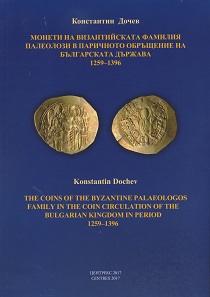by Ursula Kampmann
translated by Christina Schlögl
March 22, 2018 – People have been speaking different languages since the Tower of Babel to prevent them from achieving a divine state – at least that is what the Bible tells us. As a matter of fact, our research in every field of science would probably be more advanced, if we could perfectly understand publications in other languages. As a consequence, most researchers in numismatics have chosen to publish their studies in English in order to be understood. And it is for this very reason that the Bulgarian numismatist Konstantin Dochev has not just included an English summary of his comprehensive study on Byzantine currency in the Kingdom of Bulgarian during the Palaiologos dynasty, but he has also added a bilingual catalogue.
Konstantin Dochev, The coins of the Byzantine Palaeologos Family in the coin circulation of the Bulgarian Kingdom in period 1259-1396. Centrex 2017. 2 vol.: Vol. 1: Text. 308 p., with diagrams in bw. Vol. 2: Catalogue. 215 p. with images in bw and 4 plates in bw. 29.6 x 21 cm. Paperback. ISBN: 978-954-913-083-6. 80 euros plus postage.
Professor Konstantin Dochev is famous in Bulgaria for his expertise in the medieval coinage of the Balkans. He is head of the Veliko Tarnovo Office of the National Archaeological Institute with Museum in Sofia. In this capacity, he is one of the experts who work closely with the police to prevent treasure hunts with metal detectors and illegal antiquities trade.
His current study revolves around the circulation of Byzantine gold- and bronze coins of the Palaiologos, more precisely, the period between the destruction of the Second Bulgarian Empire, or the recapture of Constantinople by the Byzantine ruler in the year 1261, and the Battle of Nicopolis in 1396, when the last Bulgarian sub-empire was lost to Ottoman rule.
Today, Bulgaria is located north of Turkey and Greece. From a historical viewpoint, the Bulgarian Empire was a direct neighbour of the Byzantine Empire and it effectively sealed it off to the northwest. Consequently, if people did not take the sea route to do trade, they had no other choice but to cross the country. It is thus not surprising that Byzantine money was flowing to Bulgaria in large quantities.
Dochev examines which coins were found where and when. His research, which mostly relies on a high number of hoards, surface finds and settlement features, enables him to secure the chronology of the Palaiologos’ coinage. His catalogue is therefore not just for scholars but also for coin dealers and coin collectors with scholarly ambitions. If you want to be able to date coins according to the current state of research, you have to use this catalogue.
In terms of usability, Dochev does not just rely on photos, since they are mostly insufficient due to the coins’ dish-like shape which makes it extremely difficult to capture every detail. Instead, he provides an additional drawing. Moreover the WHOLE CATALOGUE is bilingual, which will be a delight to every Western reader. After all, Bulgarian is written in a Bulgarian version of the Cyrillic alphabet and is thus completely unintelligible for an inexperienced user.
It is for the same reason that every reader will appreciate the eight pages that summarise the study and serve as the base for academic discussion.
Now all that is left to do is hope that the book will find the recognition it deserves amongst all those who occupy themselves with Byzantine numismatics.
If you want to order the book please contact Dr. Plamen Patchev in Sofia.






